Exploring Montana’s Best Last Places
See the entrance to 48 Montana cemeteries. The 1,500 mile tour begins in Central Montana, followed by gates in NE Montana, SE Montana, SW Montana, Western Montana and ends in the NW corner of the state.
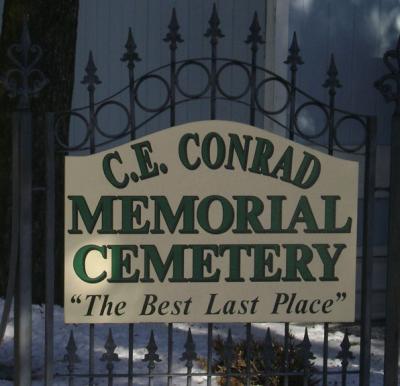
Ever walked through a cemetery and imagined footsteps behind you, rustling in the leaves, or bony hands reaching up through the layers of the moldy earth?
Since the beginning of time, places of the dead have harbored spirits, real and imagined. From Pioneer burial grounds to landscaped cemeteries, Montana has more than a few with poignant histories, mysterious quirks, and ––some say –– lingering spirits where you may encounter the energy of those who rest, or don't need rest, among the tombstones

Montana’s cemeteries reflect the state’s history and sometimes reveal the darker side of a community. The cemetery at the great silver camp of Elkhorn, for example, tells the story of a 1889 epidemic that claimed most of its children. But lesser known is the reason for the common grave of two young boys, Albin Nelson and Harry Walton, who miraculously escaped the epidemic. Months later, they blew themselves up when they found and exploded a canister of gunpowder.

Cemeteries also reflect cultural traditions. At Helena’s Home of Peace, Montana’s oldest active Jewish Cemetery, curbs and brick walkways recall the camaraderie of a neighborhood. Instead of flowers, visitors leave stones symbolizing remembrance that survives after earthly things wither. A Chinese funerary burner at Butte’s Mount Moriah Cemetery illustrates the tradition of burning monetary offerings and the deceased’s belongings for the journey to the afterlife. And along the Hi-Line, graves at Sacred Heart Cemetery—adjacent to the eerie, boarded-up abandoned mission church—include personal tributes such as a lariat, a tennis shoe, a basketball, and other treasured reminders of loved ones gone.
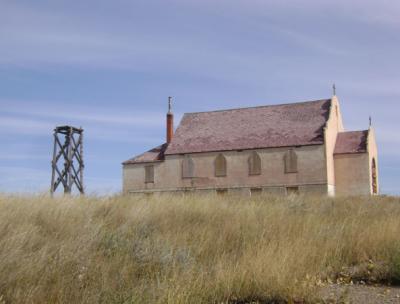
In Montana, as elsewhere, small urban cemeteries were originally haphazard and families cared for their own plots. But people moved on or died, graves were forgotten, and neighborhoods developed over them. Large, planned, and landscaped cemeteries, a 19th century innovation, began to serve as parks where residents could enjoy nature, picnic, and reflect. Montana tapped into this movement. While some garden park cemeteries, like Bozeman’s Sunset Hills and Billings’ Mountview, evolved in the 20th century from smaller, pioneer burial grounds, a few originated as formally planned cemeteries.
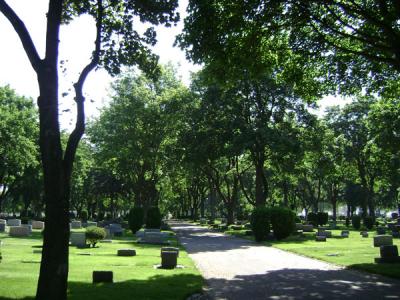
Butte’s Mount Moriah, one of Montana’s first planned cemeteries, came about of necessity in 1877 when underground mining caused urban burials to rise to the surface. Pollution allowed nothing to grow, so the cemetery was bleak. Butte compensated with artful tombstones. By 1905, as smelting moved to Anaconda, trees and shrubs began to revegetate. The once-barren grounds, beautiful today, include attractive cemetery sculptures.
Missoula’s City Cemetery (1884) and Helena’s Forestvale (1890) were both professionally planned and landscaped. But it is the C. E. Conrad Memorial Cemetery in Kalispell that is Montana’s true garden park prototype.
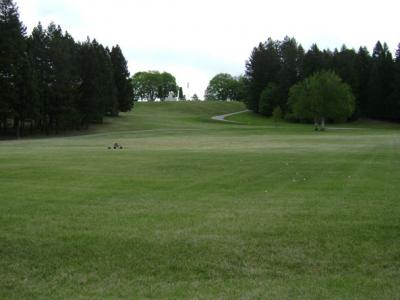
Kalispell founder Charles Conrad had little time left when he and his wife Alicia took a final horseback ride to a favorite promontory in 1902. Charles asked to be buried there. Weeks later Alicia not only carried out his wishes, but also began to plan a community cemetery. She traveled widely and found a landscape architect and experienced cemetery manager in A. W. Hobert of Minneapolis. Hobert designed the C. E. Conrad Memorial Cemetery in 1905 as a formal garden park cemetery. Today, 104 acres include winding driveways, sweeping lawns, and formal plantings that blend into the natural setting.
The mysterious Fairy Steps, known to generations of Kalispell children, provided Alicia private access to her husband’s grave. The stairway climbs a steep cliff from the wooded banks of the Stillwater River to the Conrad mausoleum. Local legend has it that if you count the steps on the way up and again on the way down, you will always get a different number.
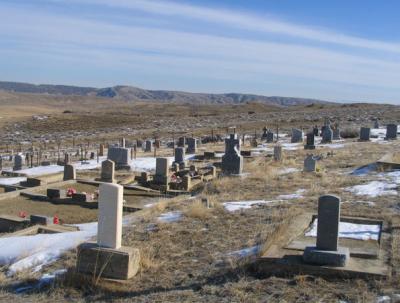
Most of Montana’s cemeteries are places of quiet beauty, but there are a few where the dead seem to seek out the living. One of these lies on a lonely hillside in Carbon County. Coal mining brought families to settle in Bearcreek and many European immigrants are buried in its cemetery. In 1943, the Smith Mine Disaster killed 74 miners and Bearcreek became a ghost town. But that was not Bearcreek’s only tragedy.
A highly intuitive acquaintance and her family visited the Bearcreek Cemetery in February 2009. She says she “saw” and talked to the spirit of a very angry man. He told her that he came to Bearcreek looking for his sister Roza and was unable to find her. He claimed he was hit by a train and killed. Research uncovered this horrific, long forgotten incident.
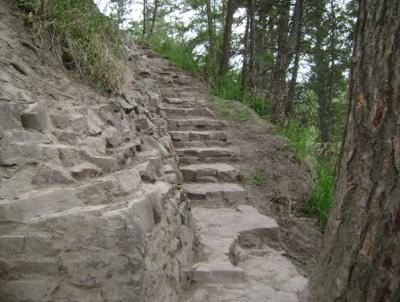
Roza Cernic died in 1917 months before her brother came looking for her. Before he could find her, he walked out of one of Bearcreek’s saloons into the path of a moving train. Killed instantly, he was buried in the cemetery’s northeast corner in an unmarked grave. When a fence later enclosed the cemetery, Cernic’s grave was left outside. That he never found his sister, died so violently, and was left forgotten outside the fence may help to explain his anger.
While Cernic’s angry spirt communicated, family members took video. The film reveals nothing odd until the last frame which clearly shows someone walking behind a bush near Cernic’s grave. All five visitors can be accounted for and it was none of them. Was this the ghost of the angry man reaching out from the grave?
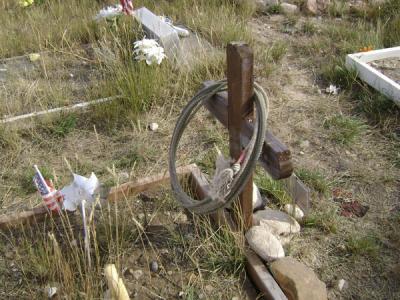
Helena’s Benton Avenue Cemetery is another haunted place, known for its several paranormal incidents. One occurred in May 2012 as fourth grade classes toured the cemetery. Three girls saw a teenager wearing a yellow dress, sitting underneath a tree. And then, they said, she disappeared. Adults discovered the nearby grave of 15-year-old Fern Marie Wilson.
Newspapers document Fern’s suicide in 1911. A psychic later confirmed Fern’s presence in the cemetery and added another detail. She saw Fern wearing a lovely lace collar over her yellow dress. In 2014, another group of fourth graders visited the cemetery. Half a dozen of them claimed they saw Fern sitting in the tree. Describing her, several girls added a detail they could not have known: Fern was wearing the pretty lace collar over her dress.
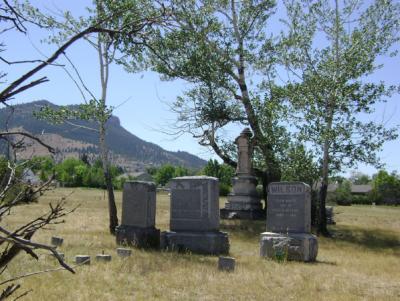
Mrs. Dunphy and the two children she cared for during a diphtheria epidemic in 1885 have also appeared at Benton Avenue. Norma Alada and Felix Kuehn did not survive, nor did Mrs. Dunphy. The three occasionally walk hand-in-hand in a grassy area between their tombstones.
One cold night during an October cemetery tour, a participant saw two children and a tall woman standing quietly away from the group. Badly frightened, she fled the cemetery long before the tour was over. The experience haunted her, and she only shared it much later.
She knew nothing of the epidemic nor did she know that diphtheria blocks one’s airway.
Yet she said she noticed right away that the children were barefoot in the cold and looked as if they had been sick a long time. All three had a strange, distorted, pinched look about their mouths, as if they were struggling to breathe.
Pioneer burial grounds, sweeping park-like vistas, and restless spirits make Montana’s cemeteries places where history, culture, secrets, and unexpected encounters await. Choose a cemetery to explore and see for yourself.
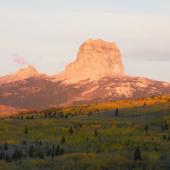

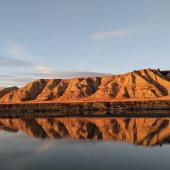



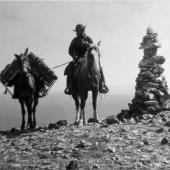





- Reply
Permalink